When you holler ‘timber’ and learn there’s a honeybee hive in that downed tree
 David Edwards places honeycomb inside empty wood frames and secures it with rubber bands. Eventually, the honeybees will add to the comb and secure it to the sides, and then chew up and pull the bits of rubber band out of the hive. (Photo by Holly S. Edwards)
David Edwards places honeycomb inside empty wood frames and secures it with rubber bands. Eventually, the honeybees will add to the comb and secure it to the sides, and then chew up and pull the bits of rubber band out of the hive. (Photo by Holly S. Edwards)
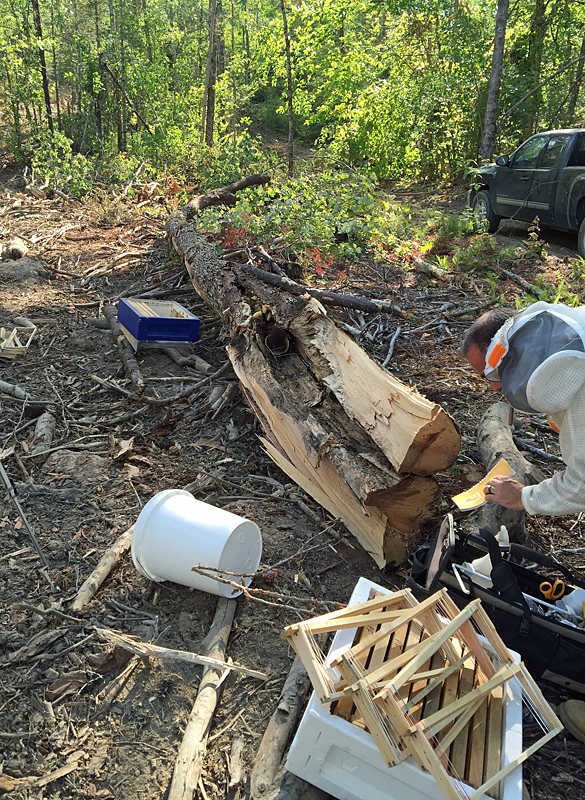 The tree that Glenn Barbour felled on his woodlot, that holds a wild honeybee colony. (Photo by Holly S. Edwards)
The tree that Glenn Barbour felled on his woodlot, that holds a wild honeybee colony. (Photo by Holly S. Edwards)
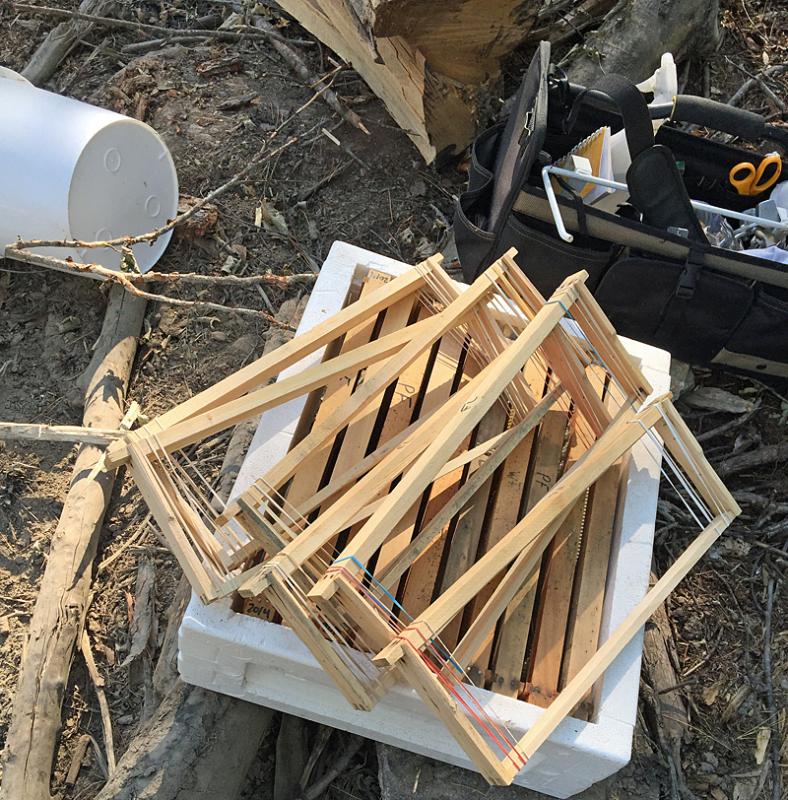 Empty wood frames, which will be the foundation upon which the honeybees live inside a new hive, ready to have honeycomb cut from the tree added to them. (Photo by Holly S. Edwards)
Empty wood frames, which will be the foundation upon which the honeybees live inside a new hive, ready to have honeycomb cut from the tree added to them. (Photo by Holly S. Edwards)
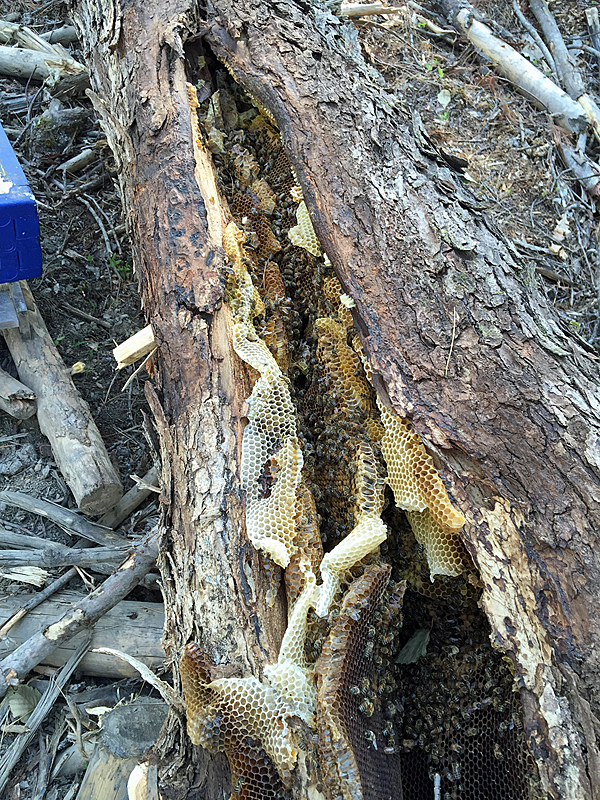 When the tree came down, portions of the hive inside collapsed and were crushed, but we were able to salvage about five frames of honeycomb, some with older capped brood, ready to hatch if they didn’t get too cold from the exposure. (Photo by Holly S. Edwards)
When the tree came down, portions of the hive inside collapsed and were crushed, but we were able to salvage about five frames of honeycomb, some with older capped brood, ready to hatch if they didn’t get too cold from the exposure. (Photo by Holly S. Edwards)
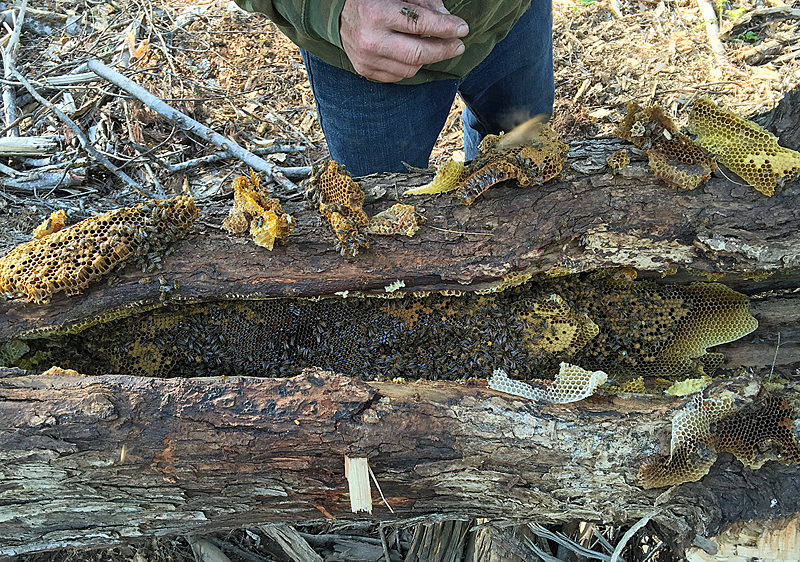 Glenn Barbour learns that drone (male) honeybees don’t sting, and he let this one sit on his hand for a quite a while. Barbour became a convert about honeybees and learned a lot as he stayed with us during the three-hour cutout we did to save this colony on his woodlot in Waldoboro. (Photo by Holly S. Edwards)
Glenn Barbour learns that drone (male) honeybees don’t sting, and he let this one sit on his hand for a quite a while. Barbour became a convert about honeybees and learned a lot as he stayed with us during the three-hour cutout we did to save this colony on his woodlot in Waldoboro. (Photo by Holly S. Edwards)
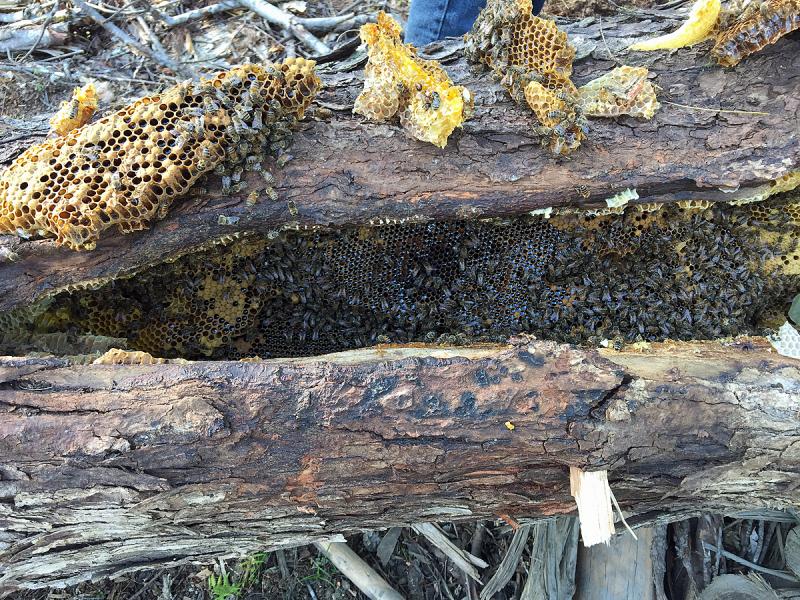 There are lots of bees to wrangle, without smoke, but they were also gentle and nobody got stung during the three hours spent moving them from inside the downed tree to a hive box. (Photo by Holly S. Edwards)
There are lots of bees to wrangle, without smoke, but they were also gentle and nobody got stung during the three hours spent moving them from inside the downed tree to a hive box. (Photo by Holly S. Edwards)
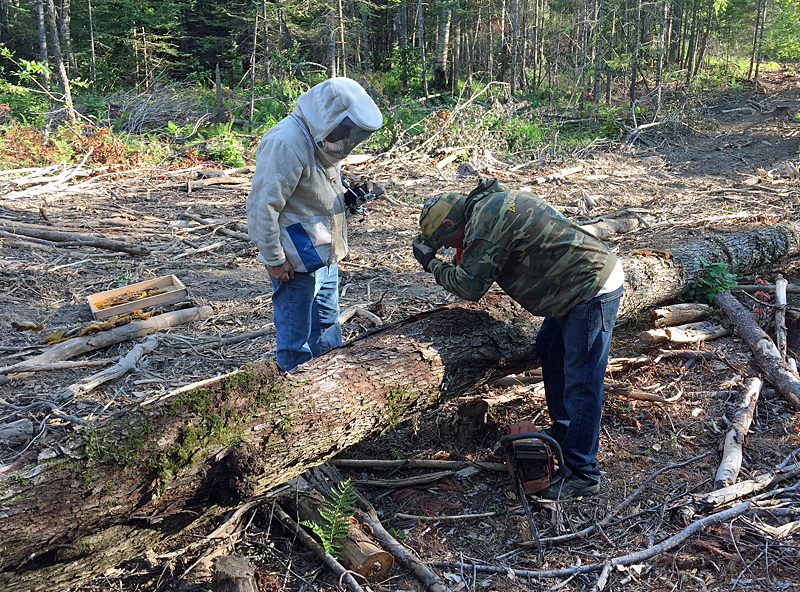 Glenn Barbour, right, and Dave Edwards talk about where the cut the tree to access the remaining colony up inside. (Photo by Holly S. Edwards)
Glenn Barbour, right, and Dave Edwards talk about where the cut the tree to access the remaining colony up inside. (Photo by Holly S. Edwards)
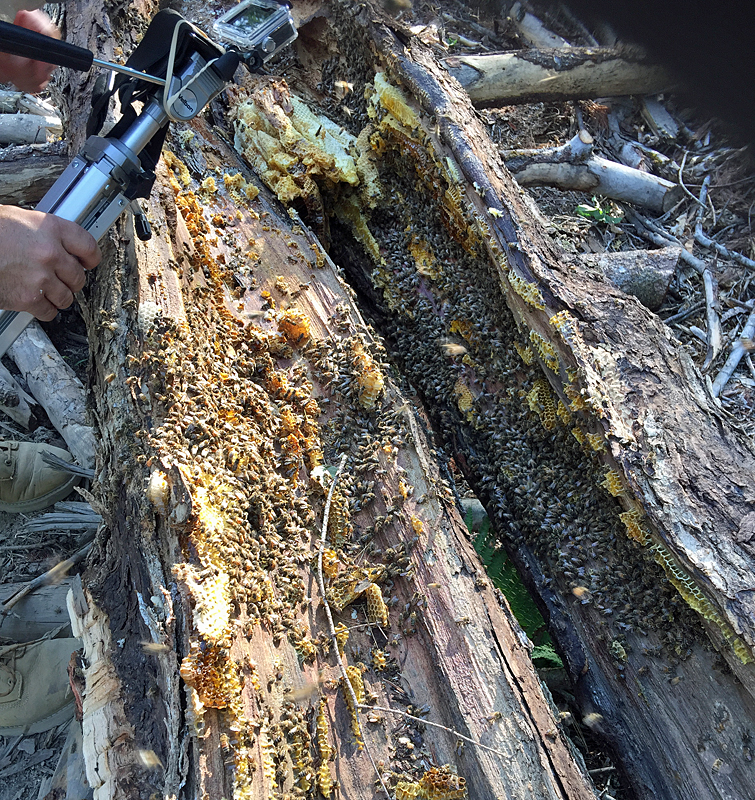 One cut with the chainsaw and the tree split open like a clam shell, making it possible to access the rest of the hive inside, to the left. (Photo by Holly S. Edwards)
One cut with the chainsaw and the tree split open like a clam shell, making it possible to access the rest of the hive inside, to the left. (Photo by Holly S. Edwards)
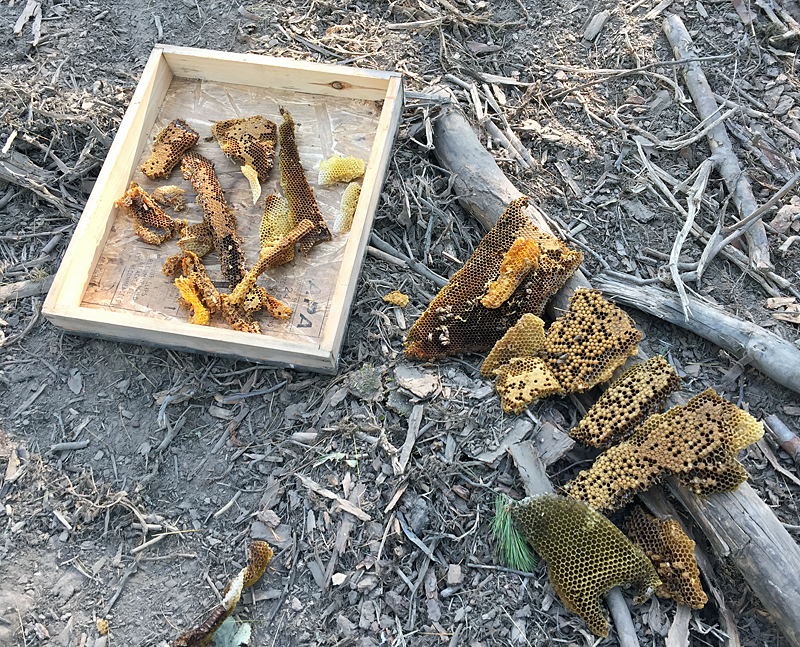 Honeycomb that will be melted and strained to remove the brood, pollen, nectar and any dead bees, resulting in a block of beeswax. (Photo by Holly S. Edwards)
Honeycomb that will be melted and strained to remove the brood, pollen, nectar and any dead bees, resulting in a block of beeswax. (Photo by Holly S. Edwards)
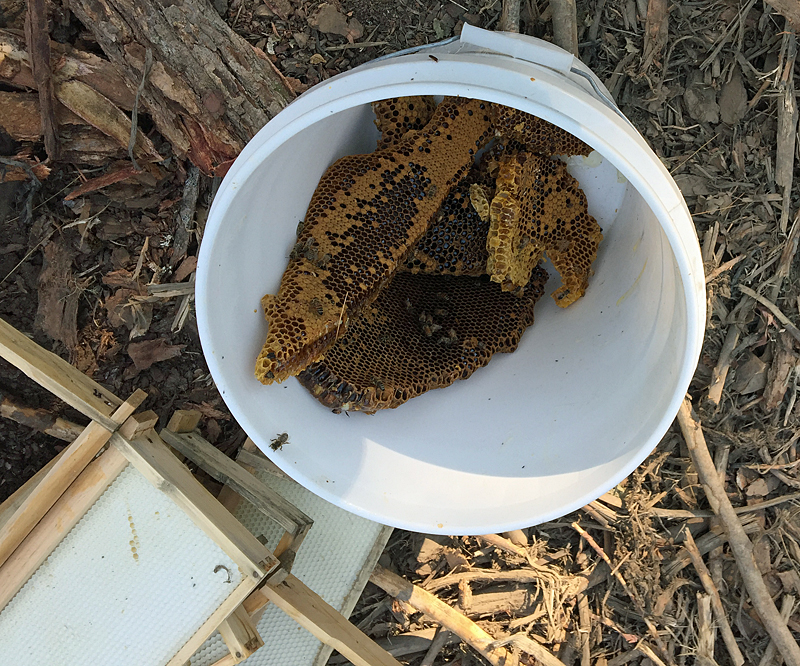 We were able to harvest a small bit of honey from this hive, but most of the honey that was left was not any good for people or the bees, as it was infested with small hive beetle larvae. (Photo by Holly S. Edwards)
We were able to harvest a small bit of honey from this hive, but most of the honey that was left was not any good for people or the bees, as it was infested with small hive beetle larvae. (Photo by Holly S. Edwards)
 The honeycomb, which has been placed inside the wood frames and banded into place, will eventually be repaired and added to by the bees and connected to the edges of the edges of the frame with beeswax. Then, the bees will chew up the rubber bands and pull them outside the hive, if they can. (Photo by Holly S. Edwards)
The honeycomb, which has been placed inside the wood frames and banded into place, will eventually be repaired and added to by the bees and connected to the edges of the edges of the frame with beeswax. Then, the bees will chew up the rubber bands and pull them outside the hive, if they can. (Photo by Holly S. Edwards)
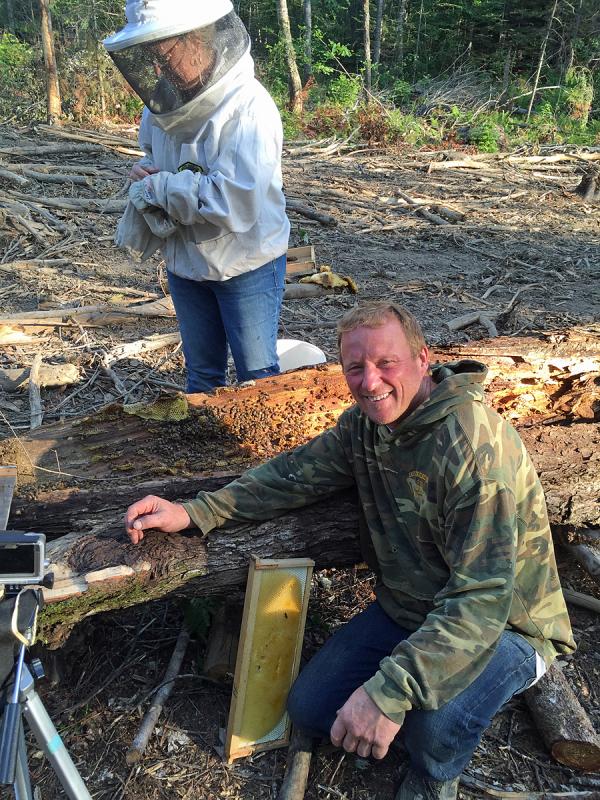 Glenn Barbour can now be counted as having a greater appreciation and understanding of bee behavior, and another great honeybee steward in the Midcoast. Edwards Apiary thanks for the opportunity to help you and the bees in your woodlot. (Photo by David Edwards)
Glenn Barbour can now be counted as having a greater appreciation and understanding of bee behavior, and another great honeybee steward in the Midcoast. Edwards Apiary thanks for the opportunity to help you and the bees in your woodlot. (Photo by David Edwards)
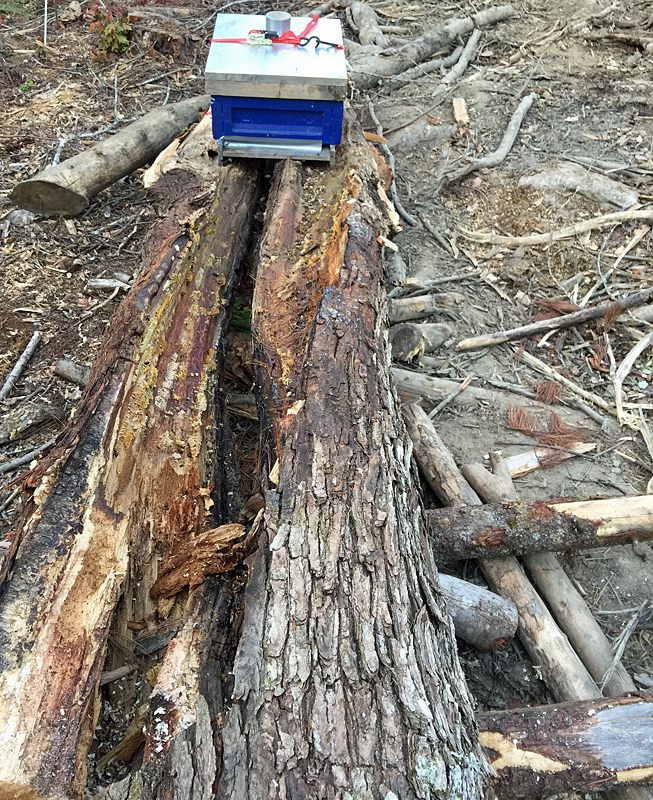 And then there were no bees left in the tree... (Photo by Holly S. Edwards)
And then there were no bees left in the tree... (Photo by Holly S. Edwards)
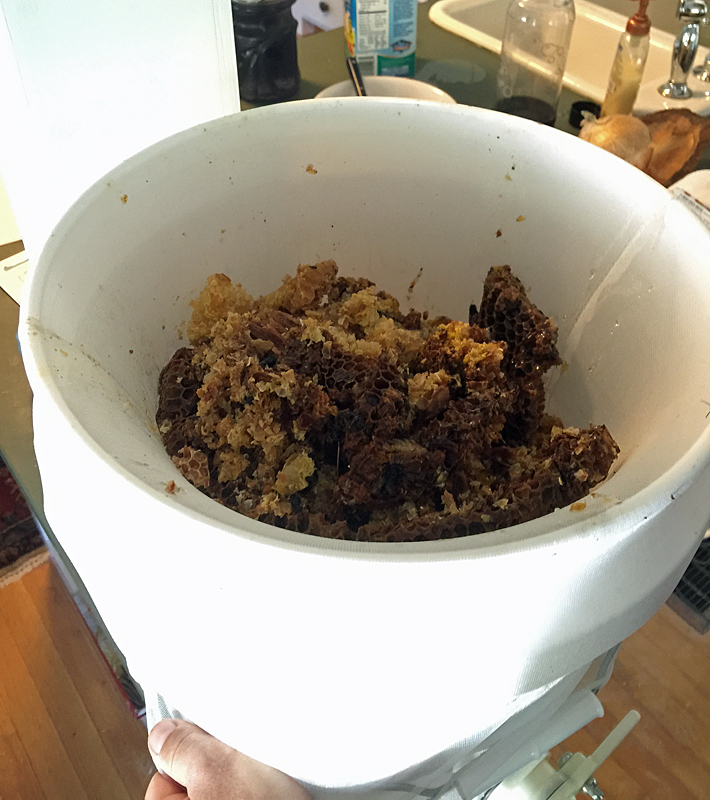 Crushing and straining the bit of salvageable honey from the Waldoboro tree cutout. (Photo by Holly S. Edwards)
Crushing and straining the bit of salvageable honey from the Waldoboro tree cutout. (Photo by Holly S. Edwards)
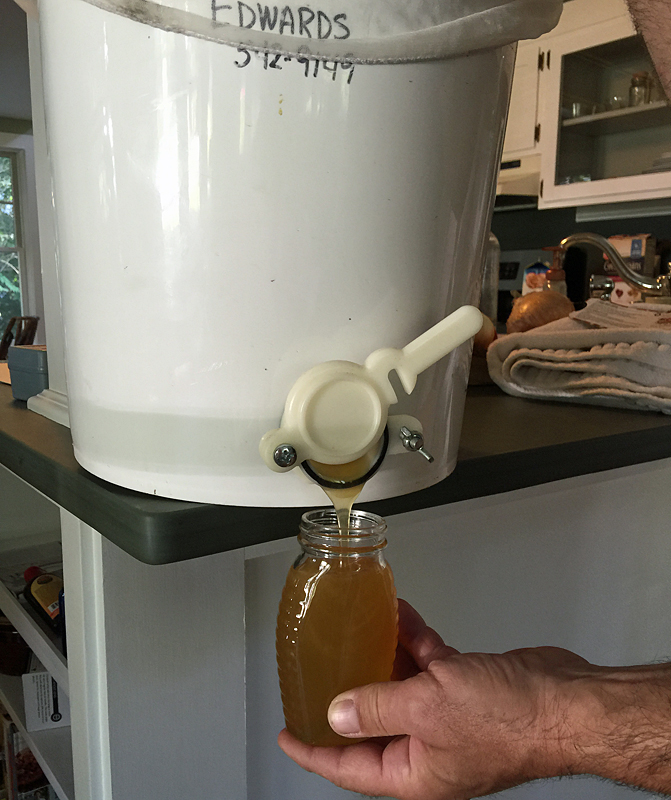 This isn’t a honey we would sell, as the quality isn’t up to snuff, but Dave is enjoying it in his daily gallon of ice tea. (Photo by Holly S. Edwards)
This isn’t a honey we would sell, as the quality isn’t up to snuff, but Dave is enjoying it in his daily gallon of ice tea. (Photo by Holly S. Edwards)
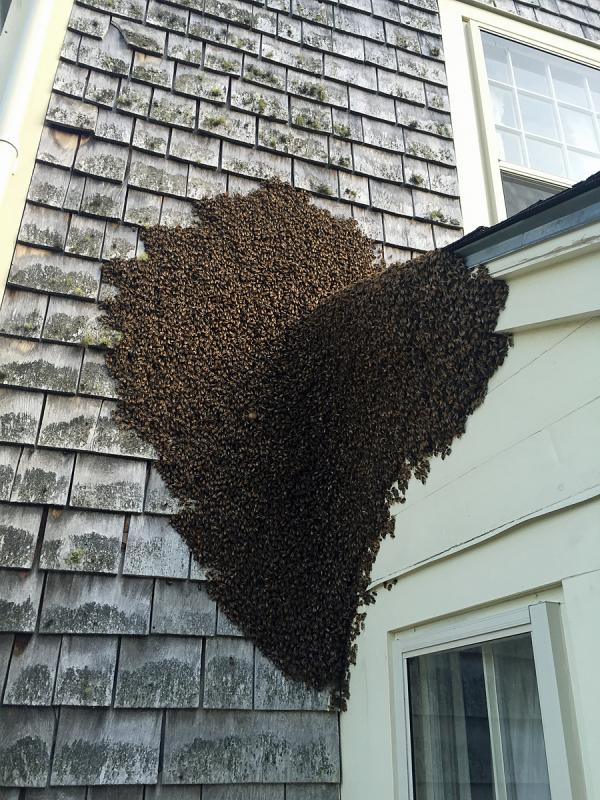 A house swarm of honeybees that Dave Edwards caught earlier this spring. It filled four boxes and made two colonies of bees. (Photo by Dave Edwards)
A house swarm of honeybees that Dave Edwards caught earlier this spring. It filled four boxes and made two colonies of bees. (Photo by Dave Edwards)
 This is what a honeybee march looks like after you successfully catch a swarm or do a cutout of a colony. Sometimes they fly off the next day, but if you are lucky and you have a queen or they really like their new home, they will stay. (Photo by Dave Edwards)
This is what a honeybee march looks like after you successfully catch a swarm or do a cutout of a colony. Sometimes they fly off the next day, but if you are lucky and you have a queen or they really like their new home, they will stay. (Photo by Dave Edwards)
 David Edwards places honeycomb inside empty wood frames and secures it with rubber bands. Eventually, the honeybees will add to the comb and secure it to the sides, and then chew up and pull the bits of rubber band out of the hive. (Photo by Holly S. Edwards)
David Edwards places honeycomb inside empty wood frames and secures it with rubber bands. Eventually, the honeybees will add to the comb and secure it to the sides, and then chew up and pull the bits of rubber band out of the hive. (Photo by Holly S. Edwards)
 The tree that Glenn Barbour felled on his woodlot, that holds a wild honeybee colony. (Photo by Holly S. Edwards)
The tree that Glenn Barbour felled on his woodlot, that holds a wild honeybee colony. (Photo by Holly S. Edwards)
 Empty wood frames, which will be the foundation upon which the honeybees live inside a new hive, ready to have honeycomb cut from the tree added to them. (Photo by Holly S. Edwards)
Empty wood frames, which will be the foundation upon which the honeybees live inside a new hive, ready to have honeycomb cut from the tree added to them. (Photo by Holly S. Edwards)
 When the tree came down, portions of the hive inside collapsed and were crushed, but we were able to salvage about five frames of honeycomb, some with older capped brood, ready to hatch if they didn’t get too cold from the exposure. (Photo by Holly S. Edwards)
When the tree came down, portions of the hive inside collapsed and were crushed, but we were able to salvage about five frames of honeycomb, some with older capped brood, ready to hatch if they didn’t get too cold from the exposure. (Photo by Holly S. Edwards)
 Glenn Barbour learns that drone (male) honeybees don’t sting, and he let this one sit on his hand for a quite a while. Barbour became a convert about honeybees and learned a lot as he stayed with us during the three-hour cutout we did to save this colony on his woodlot in Waldoboro. (Photo by Holly S. Edwards)
Glenn Barbour learns that drone (male) honeybees don’t sting, and he let this one sit on his hand for a quite a while. Barbour became a convert about honeybees and learned a lot as he stayed with us during the three-hour cutout we did to save this colony on his woodlot in Waldoboro. (Photo by Holly S. Edwards)
 There are lots of bees to wrangle, without smoke, but they were also gentle and nobody got stung during the three hours spent moving them from inside the downed tree to a hive box. (Photo by Holly S. Edwards)
There are lots of bees to wrangle, without smoke, but they were also gentle and nobody got stung during the three hours spent moving them from inside the downed tree to a hive box. (Photo by Holly S. Edwards)
 Glenn Barbour, right, and Dave Edwards talk about where the cut the tree to access the remaining colony up inside. (Photo by Holly S. Edwards)
Glenn Barbour, right, and Dave Edwards talk about where the cut the tree to access the remaining colony up inside. (Photo by Holly S. Edwards)
 One cut with the chainsaw and the tree split open like a clam shell, making it possible to access the rest of the hive inside, to the left. (Photo by Holly S. Edwards)
One cut with the chainsaw and the tree split open like a clam shell, making it possible to access the rest of the hive inside, to the left. (Photo by Holly S. Edwards)
 Honeycomb that will be melted and strained to remove the brood, pollen, nectar and any dead bees, resulting in a block of beeswax. (Photo by Holly S. Edwards)
Honeycomb that will be melted and strained to remove the brood, pollen, nectar and any dead bees, resulting in a block of beeswax. (Photo by Holly S. Edwards)
 We were able to harvest a small bit of honey from this hive, but most of the honey that was left was not any good for people or the bees, as it was infested with small hive beetle larvae. (Photo by Holly S. Edwards)
We were able to harvest a small bit of honey from this hive, but most of the honey that was left was not any good for people or the bees, as it was infested with small hive beetle larvae. (Photo by Holly S. Edwards)
 The honeycomb, which has been placed inside the wood frames and banded into place, will eventually be repaired and added to by the bees and connected to the edges of the edges of the frame with beeswax. Then, the bees will chew up the rubber bands and pull them outside the hive, if they can. (Photo by Holly S. Edwards)
The honeycomb, which has been placed inside the wood frames and banded into place, will eventually be repaired and added to by the bees and connected to the edges of the edges of the frame with beeswax. Then, the bees will chew up the rubber bands and pull them outside the hive, if they can. (Photo by Holly S. Edwards)
 Glenn Barbour can now be counted as having a greater appreciation and understanding of bee behavior, and another great honeybee steward in the Midcoast. Edwards Apiary thanks for the opportunity to help you and the bees in your woodlot. (Photo by David Edwards)
Glenn Barbour can now be counted as having a greater appreciation and understanding of bee behavior, and another great honeybee steward in the Midcoast. Edwards Apiary thanks for the opportunity to help you and the bees in your woodlot. (Photo by David Edwards)
 And then there were no bees left in the tree... (Photo by Holly S. Edwards)
And then there were no bees left in the tree... (Photo by Holly S. Edwards)
 Crushing and straining the bit of salvageable honey from the Waldoboro tree cutout. (Photo by Holly S. Edwards)
Crushing and straining the bit of salvageable honey from the Waldoboro tree cutout. (Photo by Holly S. Edwards)
 This isn’t a honey we would sell, as the quality isn’t up to snuff, but Dave is enjoying it in his daily gallon of ice tea. (Photo by Holly S. Edwards)
This isn’t a honey we would sell, as the quality isn’t up to snuff, but Dave is enjoying it in his daily gallon of ice tea. (Photo by Holly S. Edwards)
 A house swarm of honeybees that Dave Edwards caught earlier this spring. It filled four boxes and made two colonies of bees. (Photo by Dave Edwards)
A house swarm of honeybees that Dave Edwards caught earlier this spring. It filled four boxes and made two colonies of bees. (Photo by Dave Edwards)
 This is what a honeybee march looks like after you successfully catch a swarm or do a cutout of a colony. Sometimes they fly off the next day, but if you are lucky and you have a queen or they really like their new home, they will stay. (Photo by Dave Edwards)
This is what a honeybee march looks like after you successfully catch a swarm or do a cutout of a colony. Sometimes they fly off the next day, but if you are lucky and you have a queen or they really like their new home, they will stay. (Photo by Dave Edwards)
WALDOBORO — This spring, one-half of the Edwards Apiary team in Camden has "caught" nine honeybee swarms. Six were in trees near blueberry barrens, two were in trees at private residences that each had a hive that swarmed and one was removed off the side of a house. The other half of the team, yours truly, has only had time to catch one swarm. On July 16, my husband, Dave, and I were able to finally join forces and do what we call a cut-out — and save a colony of bees inside a felled tree.
Suffice it to say, we were happy to be heading out to do this kind of bee work together late that afternoon. We had never done a cut-out from a tree, and we love new experiences and opportunities to learn and test out the things we have learned.
We were so excited, it seems, we drove 10 minutes down the road and realized we didn't have a smoker. We were meeting the woodcutter, Glenn Barbour, and it was getting late into the day and didn't want to turn back.
"We'll wing it," I said to Dave. "Or we can stop at Jamie Doubleday's on Route 90 and see if she has smoker at her shop, where she has a couple hives."
Working established honeybees without a smoker can make the job much harder. Beekeepers use smoke to calm the bees and to mask their natural alarm pheromones and the pheromone given off when a bee stings skin or clothing. Smoke also moves the bees, because there is no real way to push a bee. Even with a turkey feather, which we use, you run the risk of smooshing bees or having them just fly off to another place you don't want them to be, and land right back where you pushed them from.
Worse, you might injure or kill the queen of the colony, something that will really set them back in re-establishing, and make encouraging the workers (females) and drones (males) into a new home really hard unless there is new brood (eggs, larvae, baby bees). The worker bees, especially the young nurse bees whose job it is to care for the brood, will want to stay with the brood, and their smell will attract others as well.
There is also a theory that the smoke mimics a potential forest fire, causing the bees to scurry for a gulp of honey in case they need to flee the hive. That honey will help keep them fed for the flight and give them energy, and eventually motivation, to quickly begin building new honeycomb at a new home, in which they will store new food in the form of nectar and pollen. The honeycomb also provides the framework of walls, all nearly perfectly spaced at 3/8 inches apart, on which the bees cling and live.
We stopped at Mystic Woodworks in Warren, where we would find Doubleday, but not a smoker. Instead, she gave us two soda cans and some wood shavings and wished us luck. Beekeepers are inventive; Dave especially so. We were really going to wing it after all.
On the way, I slid rubber bands over the ends of a half-dozen hive frames, three rubber bands on the left side and three on the right. As we removed honeycomb from inside the tree, we would cut it to fit inside the frames and hold it in place with the rubber bands until the bees connected it to the edges of the wood.
We learned this technique by watching hundreds of videos of other beekeepers around the world cutting out hives from inside buildings, under porches and decks, hanging from trees in year-round warm climates and even from inside a radial tractor tire. [NOTE: Some of our favorite beekeepers who video and post their work include 628DirtRooster, Ralph Jones III, JP the Beeman, Don the Fat Bee Man, The Bee Vlog, and The National Honey Show, which has informative presentations from noted biologists, scientists and more.]
Our hive boxes hold 10 frames, others use eight. We brought along four boxes, just in case we had that many bees to collect.
We met Barbour at the vacant building across from Moody's Diner, and followed him to the wood lots he and his brother own and work off Route 220. It was a dust bowl, driving back the half-mile to where he cut the tree Monday and covered it with a tarp to protect the bees. But both trucks made it there and when the dust settled, we all got out with smiles on our faces.
"I called Jean Vose and she gave me your names to call about saving these bees," said Barbour in his thick Maine accent. "I know about the situation with bees, and I really wanted someone to save them, yes sah."
We heard the "yes sah" phrase about a hundred times, and I know I smiled each time. Barbour was truly engaged with what we were about to do and he became more and more comfortable getting up close and personal the more we worked.
Barbour said he didn't realize there was a hive inside the tree until he cut it, and saw all the bees flying around from a part that split off when it hit the ground. He told us there were a lot more bees there when the tree first went down, and as we began digging around inside, we learned a possible reason why. And it had nothing to do with what happened after their home was destroyed; a common pest was already likely causing the bees to want to move on. Or they had outgrown their current space and decided to split their numbers and move on, which is what a honeybee swarm is.
We spent the first 20 minutes or so assessing and organizing our equipment. We suited up, and gave Barbour a protective veil for his face.
"There is nothing worse than a sting to your face," I told him, and he readily accepted the Maine State Beekeepers baseball cap and the $1.99 Reny's mosquito net we keep handy for these occasions with visitors.
All three of us then moved close to the tree and peered inside. We told Barbour we be looking for the queen throughout the process, and the sooner we saw her, the better. If we were lucky to find her early on, we could catch her and move her to the box in a queen catcher we keep on hand. It looks like a woman's hair clip, only instead of teeth it closes gently into a container with slits on the sides for smaller worker bees to escape out of.
I was charged with beginning the cutting, and Dave set himself up on the fallen tree. I would hand the cut sections of comb to him, and he would fit and band them into the wooden frames. It was an assembly line, with me continuing to keep a sharp eye for the queen or fresh eggs, which would be a sign she was recently there. More importantly, the presence of eggs would allow the colony to grow new queens if the original queen was killed or otherwise missing after the tree went down.
We found two things inside this old, dead tree. The first, was the presence of existing queen cells. These are large, peanut shaped cells, usually hanging from the side or bottom of a piece of honeycomb to accommodate its size. This told us, the colony was likely in the process of swarming either just before the tree was cut, or that it had already swarmed.
If they were getting ready to swarm, they would be chasing the old queen around to make her lose weight for an impending flight to a new home and beginning to create a new queen, or as many as a dozen for insurance. As soon as the first queen cell was capped, they would be ready to leave within a day or two, possibly hours.
The destruction of their home when the tree was cut was a shock to them, but bees are smart. They won't leave until they have a belly full of honey, if they can get it. And even when they are under attack from a bear that has ripped apart their hive, bees will stay with the honey and gorge before flying off, if they can. If their hive is exposed to the elements, they will cluster to stay warm and/or find a dry spot under some honeycomb and eat there, waiting for a spot of clear weather to regroup and fly off.
The second thing we found inside the tree was a cluster of squirming tiny larvae that looked like maggots. The mass of squirming white larvae was tucked up between some combs and wriggled around inside the honey the cells held. We had seen one or two hive beetles, including one nearby the larvae, and surmised that this was likely hive beetle larvae. It could have also been wax moth larvae, but since there were no webs or cocoons present, we ruled that out.
The small hive beetle is native to southern Africa and was first determined to be present in the U.S. at a commercial apiary in Florida in 1998. According to research by U.S. Extension offices, small hive beetles in Africa scavenge weakened colonies, but in the U.S. have been found to infest all colonies and cause damage and colony loss.
When a small hive beetle infests a colony, it tunnels through and ruins combs, and kills bee brood. The beetles defecate in honey and cause it to ferment, producing a "frothy mess." The bees also won't eat the honey, so they are prone to absconding to a new home.
So, between the queen cells, indicating swarming activity, and the hive beetle larvae infestation, it is likely Barbour's entire colony was well on the way to needing a new home before he cut the tree.
It took about an hour to do the cutting we could get to, and then we asked Barbour to use his chainsaw to make another cut to the tree to see if the remainder of the hive could be exposed. His one cut worked, and the tree, which was split on the backside too, opened like a clamshell.
After we had all of the salvageable comb banded onto the frames and inside the hive box, we set the box on the tree to see if the bees would take to it. The smell of capped brood, meaning larvae that is beginning to pupate into baby bees and soon hatch, and the nurse bees that stayed on that comb would be one lure to the others. We also hoped that we had scooped up the queen during the process of shaking bees off salvageable comb into the box. The queen is the number one lure to get the colony to follow.
We watched for tell-tale signs that the bees were accepting their home. Those begin with bees standing on the box entrance, lifting their back-ends in the air and fanning hard and fast. By doing this, the workers are spreading another pheromone smell that says, “this is home, head this way.”
If the bees get the message, the next sign is the march of the bees. You can literally watch the bees march across the tree, the wall, the white sheet you laid on the ground to help them along - whatever place they are, to where you want them to be. In this case, inside the box we had sitting atop the downed tree.
And we saw both fanning, and then marching. At times the march inside slowed, but it was because so many bees were climbing on top of each of other to try and make the transition from tree to box. We added a bark and stick bridge to help them, and pushed them along with the turkey feather. We also had a tiny bit of smoke from burning wood shavings and pine needles inside the soda can, and blowing it through the opening.
As we stood and watched and waited for the last of the foragers, and the scouts looking for a new home, to return to the tree and make their way into the box, the sun was headed down and the mosquitoes came out. In the distance, a red fox vixen started crying alarm calls and then screams, which were answered by a barred owl hooting its "who cooks for you, who cooks for you all" call. The red fox's calls came very close to us a few times, but our voices kept it out of camera's range. But I'm sure the fox was peering at us through the trees, even though we could not see it.
By 7:30 p.m., we were packed up with a box of honeybees and a bucket of a small amount of decent capped honey to harvest. We ended up with a quart for our work, and we gave Barbour a few good pieces to share with his grandchildren later that night.
On the way out of the wood lot, Barbour had one more thing to show us. It was a gigantic old pine tree that would take four people to stretch arms around, with cracks and splits in its huge limbs and only a few pine needles at the very top. It was once a proud tree, and had lived many decades, but it had seen its share of Maine winters, which had taken their tolls.
"My brother told me there's a colony in this tree, and my father-in-law wants the tree down before it falls on his saw mill," said Barbour. "It's a huge job, and I'm not sure when we'll do it."
At first, none of us could find where the colony was. But as we slowed down, softened our eyes and watched around the tree instead of looking at the tree itself, the flying bees gave it away. There on the backside, in a big crack, was an entrance and a small cluster of bees outside it. And bees were flying in and out, like clockwork, bringing back the days forages and heading out for one last collection of nectar and/or pollen.
"I'll call you when it's time to take this down, and we can figure out how to do it and save these guys too," said Barbour.
We told him, yes, we would be there. It would be yet another great adventure in our world of beekeeping.
Related links:
• Need help removing honeybees or know about about a swarm in Knox or Lincoln County? Call 479-9446.
• Knox Lincoln County Beekeepers club
• Maine State Beekeepers Association
Related stories:
• Bzzzz, there's a new crop of beekeepers preparing for their bees this spring
• Two new hives of honeybees residing, pollinating in Camden
• Thomaston beekeeper makes quick work of Main Street honeybee swarm in Rockland
• Honeybee swarm catching, I'm adding that to my resume
• A beekeeper's photo journal
• Let the honey flow
• The Camden honeybee adventure is alive and well, spreading to Rockport
Recommended:
Reach Editorial Director Holly S. Edwards at hollyedwards@penbaypilot.com and 706-6655.
Event Date
Address
United States
























































